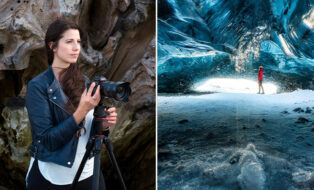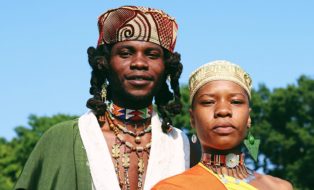Carcass Island in the Falklands is owned by Rob McGill. It’s tiny and, if you can get there, accommodation is in the owner’s house and meals are taken with the family. This isn’t at all surprising as there are no streets, shops or other amenities – and that is undoubtedly the attraction.
We disembarked at Carcass Island as part of our Peregrine Expedition through the Falklands, South Georgia Island and Antarctica. It was only a whistle-stop in the afternoon with just enough time to walk across the isthmus to the windward side. Here we saw Magellanic penguins, but it wasn’t until I returned to the beach on the lee of the island that I met lots of Gentoo penguins.
Walking along the beach, we looked down at the penguins who barely acknowledged our presence. One of the highlights of visiting these remote locations is that the wildlife are relatively unafraid of humans. However, a human perspective creates a relatively boring camera angle. One of the best angles for a penguin is around penguin height, so I lay down on my stomach and put my camera to my eye.
The issue on this day was the wind-blown sand which added to the atmosphere in the photographs, but worried me a little as I had several weeks left and I didn’t want to lose a camera due to mechanical failure! However, I needn’t have worried as the Canon EOS 1Ds Mark III and 300mm f2.8 telephoto had sufficient weather-proofing to handle the little breeze on Carcass Island!
As always, time is short. You are always balancing your opportunities: do I stay here longer and hope to get an even better photograph, or do I move on and hope to discover something else?
Back on board the Akademik Sergey Vavilov, I would look through my files for an image with a difference. Everyone had great photographs of penguins (although using a telephoto with the lens wide-open at f2.8 helped to create a slightly different look to a compact camera), so I was relying on my subjects to provide the sparkle!
I’m not sure how you view and edit your photographs, but I really like to start with a file that is precisely focused. It annoys me when my focus is slightly out and although you can try to salvage it with unsharp masking techniques, nothing beats an image that is focused correctly in the first place.
However, enlarging each image in turn to see if it is sharp around the eyes takes time. It’s not slow if you have a fast computer, but it’s time consuming nevertheless. This is where Capture One Pro 6 really helps. Turning on its Focus Mask feature, Capture One colours areas of sharp focus with a green mask (you can change the colour of the mask to any colour you like). This allows you to instantly recognise if a photograph is sharp or not.
For instance, with the series of a Gentoo penguin making a call, I could tell instantly if my subject was in sharp focus or not.
Of course, if you have several great shots, it then becomes a matter of which one do you use? I felt I had two contenders – one with the Gentoo’s head back and beak open, a second with the head thrust forward but the beak closed. I’m still not sure which one is the best…
The original raw files were quite acceptable, but lacking a little in contrast and colour. Fixing them was very straightforward using Capture One. If you’d like to see how I worked on this file, you can access a short video on the Better Photography website here.
See all the images Peter chose here
Peter Eastway is a professional photographer and photography magazine publisher based in Sydney, Australia. To see more of his photography, visit http://www.petereastway.com/. Peter also offers an online Landscape Photography MasterClass. Details can be found at http://www.betterphotography.com/.
Peter Eastway
Peter Eastway’s passion is undoubtedly for landscape photography, but he is equally comfortable with portraiture, advertising and travel. He is currently an AIPP Grand Master of Photography, one of only a dozen in Australia and earned from a career spanning over 30 years.








Great article, but there is an error in mr Eastway’s link. You have to check the link and correct it.
Hi Peter,
Reading your commentary and enjoying the accompanying images shot on your Peregrine Adventure to the Falklands on route to South Georgia and the Antarctic Peninsula brought vivldy to mind my own experience of this same voyage in December 2010.
I too tossed up on many an occasion “do I stay or do i move on?” when photographing the wildlife. i was using a Nikon 2X and a 70-300mm lens with a tripod wherever posssible. i also took a D80 and a wide angle lens too. i was always last back into the zodiac after an excursion. These stops seemed too brief. It was a humbling priviledge to be in the presence of the diverse inhabitants in this wilderness landscape.
“Woody” and Annie (husband and wife) were the expedtion leaders on the trip i made with Peregrine. They were fantastic as were the rest of their team and the crew.
i have met you on one of your sojourns to NZ.
With kind wishes
Sue
Nice video-dscription of your editing.